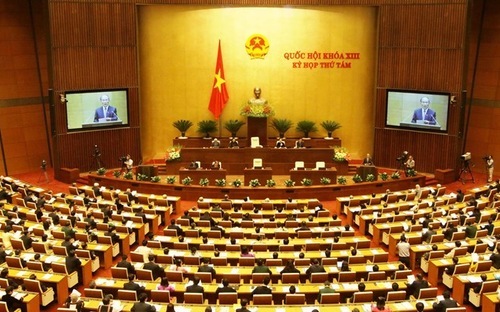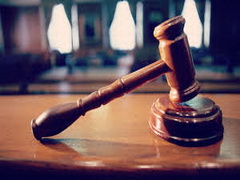In the process of judicial reform (with the Court as the center), the limitations of adjudication have become one of the topics attracting the attention of many researchers, criminal procedure law educators, as well as practitioners dealing with criminal procedures.
Limits of Prosecution in the Criminal Procedure Codes Before 2015
To date, in our country’s criminal procedure legal documentation, there has been no mention of “limits of prosecution.” Instead, they list activities that the courts are allowed to perform during various stages of the proceedings, expressed through terms such as “limits of initial trials,” “scope of appellate review,” and “scope of supervisory review.”
The author states that the criminal procedure law regulates the limits of initial trials based on the functions and duties of the Procuracy (VKS) and the Courts in criminal proceedings; the basic principles of criminal procedures; the relationships between different stages in criminal processes; the relationship between the scope of initial trials and the limits of appeals and appellate protests; the role of courts in contests during initial criminal trials; and the need to resolve unresolved opinions between the Procuracy and the Courts, ensuring the rights and legal interests of the accused and defendants.

Illustrative image
From a legislative perspective, before the 1988 Criminal Procedure Code (CPC), the matter of limits of prosecution was regulated by Circular 16-TATC dated September 27, 1974, from the Supreme People's Court, guiding the trial procedures for criminal initial cases. According to it, when resolving the charges and applied laws, if the court disagrees with the Procuracy’s opinions, they must hold a pre-trial meeting with the same level Procuracy within 15 days from the date the court accepts the case. At the meeting, if the Procuracy agrees with the court, the evidentiary file is returned for supplemental investigation to amend the indictment. If the court disagrees with the Procuracy about the amendment, the court must still bring the case to trial, but in the decision to bring the case to trial, it must state the charges the Procuracy has prosecuted and the charges the defendant may be prosecuted for. For cases where the court and the Procuracy do not agree on the charges, the trial panel will make a decision based on the actual situation at the trial. This Circular thus affirmed the court's independent role in trials, allowing the trial panel to rely on cross-examinations and contests at the trial to decide the charges independently from the Procuracy’s indictment.
After a long period implementing the above Circular, for the first time, the limits of prosecution were regulated in Article 170 of the 1988 CPC as follows: The court only tries the defendants and acts according to the charges that the Procuracy has prosecuted and the court has decided to bring to trial. Thus, the court does not try persons and acts not prosecuted by the Procuracy and cannot sentence for heavier charges than those prosecuted by the Procuracy. Although Article 170 does not limit the court from applying a heavier penalty frame than what the Procuracy has prosecuted, if the court wants to issue a heavier penalty, before holding the trial, they must confer with the Procuracy as guided in Section II of Inter-Agency Circular No. 01/TTLN dated December 8, 1988, by the Supreme People's Court and the Supreme People's Procuracy, and follow the jurisdiction regulations guided by the Circular. This regulation limited the independent principle of prosecution and accurate prosecution, leading to various requests from courts at all levels for amendments.
Based on absorbing opinions and surveying practice, the 2003 CPC amends Article 170 of the 1988 CPC into Article 196, with additions: The court only tries the defendants and acts according to the charges prosecuted by the Procuracy and decided to bring to trial by the court.The court may try the defendants under a sub-clause different from that prosecuted by the Procuracy within the same statute, or for a different charge, equal to or lighter than those prosecuted by the Procuracy.
The above additions show that the limits of prosecution have been expanded, but the court only tries according to the charges prosecuted by the Procuracy and only issues different or lighter sentences than those prosecuted by the Procuracy. This is a limitation of the statute, sometimes leading to inaccurate sentencing relative to the defendant's actions, diminishing the effectiveness of crime prevention and control. For example, for the same act of using weapons to assault and cause injury, the Procuracy prosecutes for the crime of intentional injury, but during the trial, the trial panel finds sufficient grounds to convict for murder. If the case file has been returned for supplementary investigation but the Procuracy does not amend the charges, the trial panel still must try the defendant for intentional injury and then recommend an appeal.
This issue was only resolved with the 2015 CPC (Article 298), with certain changes similar to regulations before the 1988 CPC.

Illustrative image (According to Court Journal)
Limits of Prosecution in the 2015 CPC
Article 298 2015 CPC is specified as follows:
The court tries the defendants and acts according to the charges prosecuted by the Procuracy and decided to bring to trial by the court.
The court may try the defendants under a different sub-clause within the same statute or for a different charge, equal to or lighter than those prosecuted by the Procuracy.
If it deems necessary to try the defendants for heavier charges than those prosecuted by the Procuracy, the court returns the file for the Procuracy to re-prosecute, clearly notifying the defendants or their representatives, and the defense counsel. If the Procuracy maintains the prosecuted charges, the court has the right to try the defendants for those heavier charges.
Compared to Article 196 of the 2003 CPC, Article 298 of the 2015 CPC adds a third clause. The new regulation expands the scope of prosecution, allowing the court to try the defendants for heavier charges than those prosecuted by the Procuracy. However, for the court to try for heavier charges than prosecuted by the Procuracy, the court must return the file for the Procuracy to re-prosecute, and if the Procuracy maintains the charges, the court can try the defendants for those heavier charges. This raises the question: Does the first instance court have the right to amend the Prosecutorial content?
The first view denies the necessity of the limit of prosecution or, if regulated, advocates changing its content to allow the court to determine the defendants' charges based on trial evidence, regardless of the Prosecutorial charges, including heavier charges (worsening the defendants' situation). Some authors argue that Article 170 of the 1988 CPC and Article 196 of the 2003 CPC did not adequately emphasize trial contest outcomes as required by Resolution No. 08-NQ/TW dated January 2, 2002, and Resolution No. 49-NQ/TW dated June 2, 2005, by the Politburo. They also don’t comply with the constitutional principle: “Judges and jurors are independent and only follow the law”—a basic principle in judicial organization and activities in general, and in criminal procedures, in particular. This non-compliance with the presumption of innocence might lead to non-objective, non-comprehensive case reviews because trial panels only focus on verifying whether the defendants committed the prosecuted crimes (1). Some authors further argue that the limits of prosecution do not align with the principle of "establishing the truth of the case” as regulated in criminal procedure law and face practical application issues. “In many cases, the Procuracy prosecutes for lighter crimes than the defendants committed, but the trial panel cannot convict for heavier charges. Consequently, the panel often has to recommend an appeal to higher authorities to annul their own judgments.” The view suggests the Procuracy should prosecute based on actions, and the judicial determination should rest with the court. The prosecutor’s charges should merely be a basis for courts to bring cases to trial. This doesn’t transform the court into a prosecutorial body abusing authority since, even with the right to try defendants for heavier charges, it must fit within the crime group corresponding to the defendants' deeds (2).
The second view holds that the essence of prosecution limits at first instance is the legal relationship between prosecutorial and judicial functions in criminal procedures. This relationship affects the defense function since these fundamental functions coexist inseparably. The theoretical foundation of this relationship roots in the theory of basic criminal procedure functions: prosecutorial, defense, and judicial functions are interdependent, dialectical, performed by different entities. Associate Professor, Dr. Nguyen Thai Phuc argues that each judicial body should adhere to its function: “Prosecutorial is the Procuracy’s function. Courts do not prosecute; they judge within the prosecutorial content. If the Procuracy overlooks offenses or offenders, it is their responsibility before the state, not the court’s matter. Prosecution limits by law are a strict imposition on the court’s judging function, ensuring the court remains a judging body, not a prosecutorial one. The Procuracy, representing the state in prosecuting defendants, cannot amend prosecutorial content during trials to worsen defendants’ situations. Still, the law allows courts to issue heavier charges within the same statute, worsening defendants' situations” (3).
Theoretically, both views ensure proper judicial functions. However, concerning defense rights: when courts try heavier charges, dual prosecutorial content exists: The Procuracy's official indictment and the judge’s heavier indictment at the trial preparation decision. Which prosecutorial content holds legal value, or do both equally? If the judge’s heavier indictment is considered official, the court effectively becomes a prosecutorial body, nullifying the Procuracy’s indictment, and concurrently acts as prosecutor and judge. How can the defendant exercise defense rights when facing dual prosecutorial content? The second theoretical foundation is ensuring the defendants' right to defense—a constitutional right. Defense is a crucial procedural right, with corresponding obligations for judicial bodies, including courts, to respect and facilitate defendants’ best defense opportunities, free from violations.
The author contends that resolving the prosecutorial-judicial function relationship is key, ensuring defendants' constitutional defense rights. The court, focusing on the prosecuted actions, not dependent on prosecutorial charges, determines the charges and penalties, clarified in the trial decision.
To guarantee defense rights and best defense preparation, in trial preparation, if heavier charges are deemed necessary, the judge should organize a "pre-trial" or "preliminary hearing" involving prosecutors, defense counsels, and other participants, reviewing all actions, consequences, and evidence. Based on this, the judge decides the charges and statute, potentially differing from prosecutorial charges. The pre-trial/preliminary hearing aids in resolving prosecution limits per paragraph 3 of Article 298 of the 2015 CPC when heavier charges are required. Through such hearings, defendants, and defense counsels learn the court’s view, preparing defense adequately. This ensures accurate adjudication, lowers annulment rates, and guards against wrongful first-instance convictions.
Nguyen Van Thuan (2016), “New Regulations on the Courts’ Tasks and Powers in the 2015 Criminal Procedure Code,” People's Procuracy Journal, Issue 7/2016.
http://moj.gov.vn/qt/tintuc/Pages/nghien-cuu-trao-doi.aspx.
Nguyen Thai Phuc (2003), “The Issue of Prosecution Limits in Criminal Procedures,” State and Law Journal, Issue 11/2003.
Ths. Le Thanh Phong
Vice Chief Judge, People's Court of Ho Chi Minh City
Prosecutory Journal, Issue 13/2018
Source: Procuracy
 Article table of contents
Article table of contents





.Medium.png)
.Medium.png)
.Medium.png)
.Medium.png)
